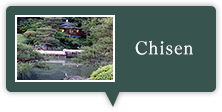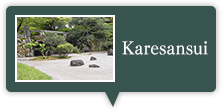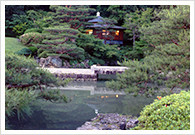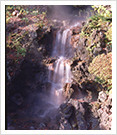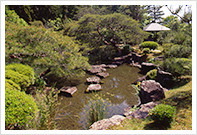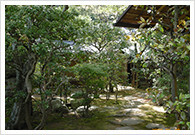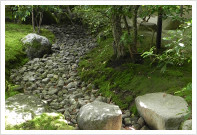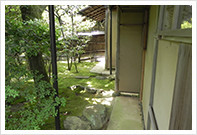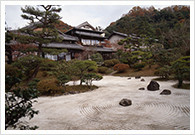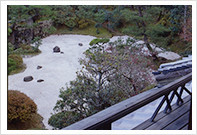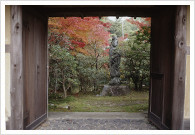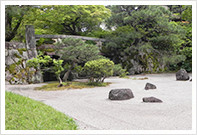Three styles of Garden
Sansuien has three styles of landscape gardens: “Chisen” (pond garden), “Roji” (tea house garden) and “Karesansui” (dry landscape).
Sansuien has three styles of landscape gardens: “Chisen” (pond garden), “Roji” (tea house garden) and “Karesansui” (dry landscape). The pond garden and moat was created in the middle of the Taisho (early 1900’s), while the tea house garden and the dry landscape gardens were created in the latter part of 1945. The three gardens while contiguous are independent. They have been highly evaluated by experts.
Trees such as pine, Hiyokuhiba, cherry and maple, shrubs such as gardenia and azalea and ground cover plants such as mulberry and other plants provide for excellent views in all four seasons.
Chisen (Pond Garden)
With the mountains as a scenic backdrop and the pond in the center, the walking path is built around the pond taking advantage of the ups and downs of the lay of the land. The pond has five coves and an island and creates a beautiful view. The river that flows into the pond comes from the hot springs water and from the two waterfalls and because of the hot spring water the carp do not hibernate, but swim vigorously year-round, entertaining the visitors. A stone bridge across the middle of the pond has become a characteristic accent of the garden. The stone bridge and natural stone on the north side of the cove, can be crossed to the south side of the bay on the opposite shore with an arrangement of stepping stones.
On the north side of the pond garden is the Rinsui tea house restaurant, ("Rinsui" means “near the water”). On the south side of the pond, there is a Manju-tei (gazebo) made in the design and construction of Sukiya and Usui Kaichiro. This is a copy of the four-seat (Manji-tei) of the Kyoto Katsura Imperial Villa.
Roji (Tea House Garden)
Roji The tea house garden has an outer area and a sand flowing inner waiting area; the inner gate (baiken-mon) a “latched gate” (tsukiage-mon) and a well turns it into a full-fledged tea garden. The path leading to it features sawa (stepping stones), an overflowing stone basin (tsukubai) and stone bridge.
In the latter part of 1945, Usui Kaichiro brought in Kyoto gardener Goto Juuei to work on the garden. Stone for the garden, black pebbles and some of the trees, etc., were brought from Kyoto.
Karesansui (Dry Landscape)
After making the tea house garden, the dry landscape garden was made by the Goto Juuei.
Several islands of stone and pine dotting a sea of white sand characterizes this low garden. Paths down to the garden can be traced from three sides so that one can enjoy its expressions from different angles.
On the south corner of dry landscape garden is nestled the thatched Ibaraki Gate. The second floor Tou-un room has become a small tea house.
This gate is a copy of the Ibaraki Gate of Jikou Temple in Yamato Koriyama, it was designed and constructed by Usui Kaichiro.
The stone Taisho era bridge across the moat from Ibaraki Gate leads over an alley to an tea house garden.


